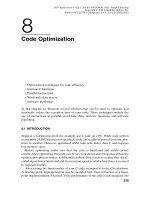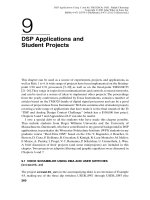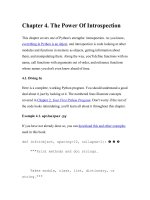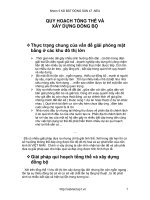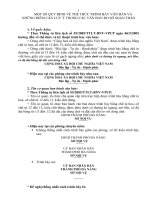Tài liệu COSMIC MAPS, PROPHECY CHARTS, AND THE HOLLYWOOD MOVIE, A BIBLICAL REALIST LOOKS AT THE ECLIPSE OF OLD TESTAMENT NARRATIVE* ppt
Bạn đang xem bản rút gọn của tài liệu. Xem và tải ngay bản đầy đủ của tài liệu tại đây (262.98 KB, 17 trang )
Criswell Theological Review 7.2 (1994) 65-81.
[Copyright © 1994 by Criswell College, cited with permission;
digitally prepared for use at Gordon and Criswell Colleges and elsewhere]
COSMIC MAPS, PROPHECY CHARTS,
AND THE HOLLYWOOD MOVIE,
A BIBLICAL REALIST LOOKS AT
THE ECLIPSE OF OLD
TESTAMENT NARRATIVE*
JOHN SAILHAMER
Scholar in Residence
Northwestern College
St. Paul, MN
1. Introduction
There is a general recognition today that our society has lost its identity. It has lost its sense of a common story. Recently in a television interview, Ken Burns, the writer and producer of the PBS series
"Baseball," was asked why he chose to devote such time and attention
to the game of baseball. His answer was surprising, but insightful.
Baseball, he said, is the only common story that Americans still share.
A generation ago, Americans had a much more comprehensive story.
That story was rooted in a shared experience. It was, moreover,
founded upon a common religious heritage. That heritage was, in fact,
a continuation of the Biblical story. With the collapse of that story,
however, the only remaining thread in the common bond of American
society is now baseball. Thus Ken Burns, the PBS producer, set out to
tell the story of baseball. It was an effort, he said, to bring our country
together.
Without a story to define us as a nation, we cease to act as a nation
and, really, cease to be a nation. I think we would all agree that the
loss of our nation's story is a serious problem today and affects every
part of life. There is, however, an even more serious loss of story. The
Christian Church also has a story. That story is told in the Bible. To the
* This article represents the two lectures read for the annual Criswell Theological
Lecture, February, 1995.
66
CRISWELL THEOLOGICAL REVIEW
extent that our individual stories are linked to the biblical story, our
lives have meaning and purpose. If we should ever lose that story, or
if that story should be changed in any way, we will quickly forget
who we are. One of the central tasks of Christian education is to ensure that the biblical story continues to be told. An equally important
task is to ensure that the story is preserved intact. It is my contention
that the biblical story is in danger today of being distorted, accommodated, changed, and ignored. Some of those pressures are exerted by
the Bible's own best friends.
2. The Biblical Story
I want to address the issue of the biblical story. I want to talk about
what makes it tick. Why is it so important? What threatens it today?
As my title suggests, I want to approach the biblical story under
three headings: 1) cosmic maps; 2) prophecy charts, and; 3) the Hollywood movie. These three headings, I think, point to, or at least illustrate, the essential function of the biblical story. That function is to give
us a sense of the nature and purpose of God's world. In the words of
N. Goodman, the biblical story is a "way of worldmaking."l
2.1. "Cosmic Maps"
Let's begin by looking at "cosmic maps." I am taking the idea of a
"cosmic map" from the Yale theologian G. Lindbeck. In his book, The
Nature of Doctrine, Lindbeck addresses the question of the nature of
religion and theology in a "post-liberal" age. What he means by a postliberal age is that in his view classical liberalism has come to an end.
We live in an age which has come to appreciate the essential limitations, indeed fallacies, of classical liberalism. Liberalism was born out
of the Enlightenment notion that reason, or human experience, is the
ultimate source of truth. Religion, according to the Enlightenment and
modern liberalism, consists of a basic "core experience" of reality. Every
human being has such a "core experience," or at least is capable of having one. Theology is the specific, culturally conditioned expression given
to one's "core experience." Religion and theology are like the eruption of
a volcano. The core molten lava of religious experience breaks through
the crust of the earth's surface at various places and forms a volcano. A
whole ecological system then forms around the volcano. That system is
analogous to theology. Liberalism's view of the religion and theology
1
Nelson Goodman, Ways of Worldmaking, Indianapolis: Hackett Publishing Company, 1978.
John Sailhamer: ECLIPSE OF OLD TESTAMENT NARRATIVE 67
of the Bible, for example, is that the biblical story is Israel's expression
of their "core experience." Christianity is also a volcano that has broken
through the earth's surface at a particular time and place. Liberalism
leads to pluralism because all "religions" are merely the cultural-bound
theological articulations of a common "core experience." Behind all religions lies the same deep structural "core experience." All religions are
expressions of the same basic truth.
Lindbeck argues that liberalism is simply wrong. There are no
universal "core experiences." That is not the way cultures and religions
work. What we know about religions today, says Lindbeck, suggests
another, quite different, explanation. Religion is an essential feature of
culture. Religion is a component of culture in the same sense as language is a component of culture. Religion and language are what create the basic semantic structures of culture. They are not created by
culture. They create culture. Language gives a culture its essential surface structures of meaning. It defines for a culture the ways it organizes
its world--both the physical world and the world of its ideas. Religion
gives a culture its essential deep structures of meaning. Religion tells
a culture what is real and not real, what is true and what is false, what
is good and what is evil. Religion tells a culture what lies behind the
world defined for it by language. Religion tells a culture about the nature of God, humanity, sin, and redemption. Religion gives a culture the
grammar with which it seeks to express itself.
In other words, for Lindbeck, there are no common "core experiences," at least not any that can serve as a meaningful deep structure.
Religions, like individual languages, have their own distinct idioms. Each
religion has its own unique way of defining human experience. There
are no common deep structures. Human experiences are essentially
semantically neutral until they are refracted through a particular religious prism. Within cultures, faith and religion serve as interpretive
schemes which, like language, a culture uses to give meaning to human
experience. "Religions are seen as comprehensive interpretive schemes,
usually embodied in . . . narratives. . . which structure human experience
and understanding of self and world."2 Thus the biblical narratives and
their story, as Lindbeck sees it, are "similar to a (linguistic) idiom that
makes possible the description of realities, the formulation of beliefs,
and the experiencing of inner attitudes, feelings, and sentiments. . . it is
a communal phenomenon that shapes the subjectivities of individuals
rather than being primarily a manifestation of those subjectivities."3 To
2
3
Lindbeck, 32.
Lindbeck, 33.
68
CRISWELL THEOLOGICAL REVIEW
become religious in such a scheme "involves becoming skilled in the
language, the symbol system of a given religion. To become a Christian
involves learning the story of Israel and of Jesus well enough to interpret and experience oneself and one's world in its terms."4 In the
model of culture suggested by Lindbeck, the biblical story is the language of a culture which gives common shape and meaning to human
experience. How does it do this? Lindbeck argues (and I agree) that
the Bible structures culture (whatever culture) by means of its narratives. The biblical narratives are a "cosmic map." They are the comprehensive interpretive scheme which shows the fundamental structures
of reality. What is true, good, and real in the biblical narratives are,
in fact, what are to be taken as true, good, and real. The world we
experience as readers of the Bible is the only real world. To be true
and real, our own individual world must conform to the world we read
about in the Bible. It is no accident that the Bible opens with the statement, "In the beginning God created the heavens and the earth." The
Bible begins with the one and only reality that preceded its world, that
is, God. God alone exists eternally. All else is dependent on him and
owes its origin to him. From that starting point the Bible begins to unfold its cosmic map. From that point the Bible begins to define what is
real and what is not real, what is true and what is false, what is good
and what is evil. Like the lexicon and grammar of a language, the
Bible gives shape and meaning to our world by presenting it to us as
a totality.
An important aspect of Lindbeck's view of culture and religion is
the active role which the biblical narratives play in defining the nature
of reality. "Human experience," says Lindbeck,
"is shaped, molded, and in a sense constituted by cultural and linguistic
forms. There are numberless thoughts we cannot think, sentiments we
cannot have, and realities we cannot perceive unless we learn to use the
appropriate symbol systems. . . . A comprehensive scheme or story used to
structure all dimensions of existence is not primarily a set of propositions
to be believed, but is rather the medium in which one moves, a set of skills
that one employs in living one's life. . . . Thus while a religion's truth claims
are often of the utmost importance to it (as in the case of Christianity), it
4
"A religion is above all an external word, a verbum externum, that molds and
shapes the self and its world, rather than an expression or thematization of a preexisting self or of preconceptual experience. The verbum internum (traditionally equated by
Christians with the action of the Holy Spirit) is also crucially important, but it would be
understood in a theological use of the model as a capacity for hearing and accepting the
true religion, the true external word, rather than as a common experience diversely articulated in different religions." (Lindbeck, 34)
John Sailhamer: ECLIPSE OF OLD TESTAMENT NARRATIVE
69
is, nevertheless, the conceptual vocabulary and the syntax or inner logic
which determine the kinds of truth claims the religion can make."5
What Lindbeck is getting at here, I think, is that the Bible, and particularly its narrative, creates and defines for us the fundamental nature
of the world in which we live. It is within that world that the Gospel
makes sense. The Bible provides the "cosmic map" within which the
lost can see that they are lost and also by which they can find their way
home. Central to the biblical world is the need of redemption and the
possibility of atonement.
I would now like to turn to three personal ways in which my own
"cosmic map" has been formed. In some respects, I am representative
of many in my generation. In other ways I am not. I give these examples from my own personal experience because they provide an
illustration of how "cosmic maps" work, and ultimately, how the Bible
structures our reality.
2.2. How are "Cosmic Maps" formed? Three examples from my own
personal experience
2.2.1. Prophecy Charts. When I was growing up, my father was a
pastor and an evangelist. In our church we used to have what was
called a "prophecy chart" hanging in the front of the sanctuary. That
prophecy chart was one of my first "cosmic maps." It was a rather
conspicuous one at that. It was a large piece of painted canvas--like a
banner. It had seven circles drawn on it, each representing one of the
dispensations noted in the Scofield Bible. At either end of the chart
there was a half-circle which represented "eternity past" and "eternity
future." In the middle of these two parts of eternity there stood all of
human history. At the end of history stood the "Great Tribulation," the
"Millennium," the "Great White Throne Judgment," and the "Lake of
Fire." It was not difficult in that church to know the "big picture." It
was also very clear where we, as a church and as individuals, stood
within that picture. In every prophecy chart I had ever seen, we were
only about 6 inches from the "Lake of Fire." I know for me, as a young
child, that prophecy chart had a powerful influence on my life. It was
like a map at the shopping mall. I always knew exactly where I was
in God's program. I learned to watch and wait for God's next act in
history. It scared me, and at the same time, it gave me comfort. I
learned how to live my life "in light of the second coming of Christ."
There is a book out today about such churches and about growing up with such expectations. It is called "Living in the Shadow of the
5
Lindbeck, 34-35.
70
CRISWELL THEOLOGICAL REVIEW
Second Coming." It is an interesting book, but, to be honest, I do not like
the title. For me, at least, and I know I speak for those in my church,
the second coming did not cast a shadow upon our lives. The second
coming cast a bright light of hope. It made every day of my young
life meaningful. It gave it direction and purpose. There was anticipation. And there was also a constant warning: Maybe today! Our youth
director would say to us, "Would you like to be doing that when Christ
returns?" or "Would you like to be in a movie theater when the Lord
returns?" I have to be honest, when I look back. Without such warnings
my life would not have been the same.
Now let me quickly say that I do not think we should start hanging prophecy charts in our churches again. It was, admittedly, a quite
unsophisticated way to create a "cosmic map." But it was effective. We
got the point. Now that I have four children of my own, I often ask
myself, What has replaced the prophecy chart for my children? How
are they learning about God's plan for the ages, the whole counsel of
God, and what the prophets say? Do they know down deep how their
lives fit into God's plan? Do they know what God's plan is? A Christian's life is like a piece of a jigsaw puzzle. We need to see how we fit
into the whole picture. The contours and colors of our lives, like a
piece of a jigsaw puzzle, are meaningless without a sense of God's big
picture. The prophecy chart once did that for many of us. I do not think
it could do it again. Something, however, must take its place.
2.2.2. The Hollywood Movie. I turn now to the second way in which
I have been given a "cosmic map"--the Hollywood Movie. Throughout
all of my growing up years, I was not allowed to "go to movies." Movies were not allowed. There were only two exceptions: movies with
biblical themes (10 Commandments, David and Bathsheba) and "old
movies" on TV. Leaving aside the matter of movies with biblical themes
(which is a different subject altogether), let me say that growing up
in Southern California in the late 1950's, I saw a lot of "old movies."
Through luck or providence, my family moved to California just at the
time when KHJ-TV purchased the entire film library of RKO Studios
from Howard Hughes. That began what was then called the "Fabulous 52" series. For 52 weeks each year, KHJ-TV ran a classic Hollywood movie every night of the week and several times over the
weekend. I spent many a night, many a week, watching the same classic Hollywood movie over and over again. According to Lindbeck, What
was happening to me? Hollywood was giving me a "cosmic map." It
was a "cosmic map" made of old reruns, but it was a powerful statement about the world, the good, the bad, the true, the false--it carefully and precisely defined for me the reality of the 30's and 40's as
Hollywood had seen it. That "cosmic map" was, to be sure, a sort of
John Sailhamer: ECLIPSE OF OLD TESTAMENT NARRATIVE
71
hand-me-down. But it was a powerful map of reality. There was in those
movies, at least in my life, stiff competition between the prophecy chart
and Hollywood.
In the 20th century, the role of the movies and television, and now
videos, has been central in defining our "cosmic maps." Reality, for
many, if not most 20th century Americans, has been defined by the
movies and television. Lucy and Ricky Ricardo, Fred and Ethel Mertz,
June and Ward Cleaver--these families sometimes have more reality
than our next door neighbors. A few years ago my wife, Patty, was in
the teacher's lounge of her school. She overheard some teachers talking
about another woman whom she did not know. The teachers were talking about all the troubles this woman had gone through. Her family
problems, her health problems, her problems at work. Finally my wife
broke into their conversation and asked, in a compassionate tone which
showed she was concerned, "Who is this lady?" The teachers broke out
in laughter. They laughed because the woman they were talking about
was one of the characters in a soap opera they had been watching.
Their conversation about her was just as if she were a real person.
The noted film critic Neal Gabler has written an intriguing study
of the Hollywood film industry. He has entitled the book, An Empire
of their Own.6 Gabler's thesis is that the view of American life and of
the world which we know as the classic Hollywood film (e.g., "It's a
Wonderful Life") was, and is (as we might expect), a view of a world
that never really existed. The world of the classic Hollywood movie
was, in reality, merely the world which the Hollywood movie producers created from their own imagination. Gabler's thesis is that those
Hollywood producers created their world primarily, and principally,
for themselves. It was a world which reflected the kind of world they
themselves wanted to live in but could not. Most Hollywood producers
at that time were immigrants to this country. Their movies presented
the world of the "American Dream" which they had sought in coming
to this country, but it was a world which they had not found when they
got here. As immigrants in the early part of this century, they had been
excluded from the "real America," whatever it might have been. Thus,
having no place else to go, says Gabler, they created their own "American Dream." They created an "Empire of their own." It is that dream,
that world, which we know so well from the Hollywood movies. Louis
Mayer, the head of MGM and the most powerful man in Hollywood at
the time, spent most of his waking hours watching the movies he had
produced. He watched "old movies" just like I did. That was his world
just as it was quickly becoming mine.
6
Neal Gabler, An Empire of their Own, New York: Crown Pub., 1988.
72
CRISWELL THEOLOGICAL REVIEW
It would be interesting and tempting to diverge from our topic and
discuss just what the "world" created by the Hollywood movie was like.
It would also be fun to point out how "biblical" such a world really was.
The major producers in Hollywood during its heyday, for example, were
all fundamentally influenced by the stories of the Bible. The greatest
Hollywood producer of all time, D. W. Griffith, was quite biblically literate. In Griffith's scenes of Babylon in the classic silent film "Intolerance;" for example, Hollywood and the prophecy chart, in fact, merge
into a single image. That is true of many Hollywood films. The book has
not yet been written (that I know of) on the relationship between Hollywood and modern American evangelicalism.
I must move on, now, to my third example of how my own "cosmic map" was formed. I call this "the old fashion way"--by reading it.
2.2.3. Reading the Bible. A good friend of mine recently offered a
probing observation about me. It was an observation that you could tell
was really a form of question. He had heard me talk about my upbringing and my father and his prophecy charts. He could see I had a
deep appreciation for my heritage. He could also see I had gone quite a
way beyond the rather simplistic observations of those prophecy charts
and prophetic sermons of my father. His question was, How could I
still have an appreciation for prophecy charts? That, for me, was not a
hard question to answer. I told him that things like a prophecy chart
were of great value in my life because they pointed me back to the
Bible's own story. They forced me to return to the Bible and read it
again. They helped me read it as well. They helped me see the "big
picture." They helped me see the things which Christians in all ages
had seen in Scripture. They helped me see the hand of God in the
course of human history--a human history whose outline was given in
Scripture itself. It was a history that followed the outline of Daniel's
visions and would come to a close in the visions of St. John. To be sure,
I have been able to fill in and enrich my understanding of the Bible
many times over through my own study and reading of Scripture. Nevertheless, when I read the great theologians of the Church, Augustine,
Luther, Calvin, Cocceius, and others, I find the grasp which these men
and women had of the whole counsel of God was very near that picture of God's plan for the ages which my father's prophecy chart had
given me. The details, for sure, were different, and we may dispute
about the details. But the plan itself, was essentially that of Augustine,
Luther, Calvin--not to mention the Apostle Paul and St. John. That, of
course, was not an accident. Not only did those who drew up prophecy
charts read and reread their Bibles. They also stood on the shoulders
of many others who searched the Scriptures. They were, in fact, a part
of a long line of biblical scholars which can be traced back to the clas-
John Sailhamer: ECLIPSE OF OLD TESTAMENT NARRATIVE 73
sical writers of the 16th and 17th centuries. My father was not a biblical scholar. His teachers in Bible School were not scholars. In many
cases, in fact, they had an aversion to real scholarship. But whether
they knew it or not, their understanding of Scripture was rooted in
some of the best biblical scholarship ever produced by the Churchhere I have in mind the works of Bengel, Vitringa, Cocceius, and Crusius, the unsung heroes of modern evangelicalism. I was enriched much
further than my father ever imagined when he hung that rather crude
and unsophisticated prophecy chart at the front of our Church sanctuary.
What I am saying is that the effect which my Bible background
had on me was to point me to the biblical text. Through reading the
Bible I had been given a biblical, that is, textual "cosmic map." I had
something, though in a very simple way, which the prophets, the apostles, and the great theologians of the Church had themselves cherished.
I had a world that was fundamentally informed and structured by the
Scriptures. I had the heritage of all 20th century evangelicals--the heritage of Scripture, I had the privilege to grow up among a people who
held the Bible to be God s Word, and who understood Its world to be
the only real world.
Then something very different happened to me. I graduated from
college and went to seminary. From that experience I nearly lost it all,
That is, I nearly lost my biblical "cosmic map." I nearly lost it, not because seminary was a challenge or a threat to my faith. The reason I
say I nearly lost my cosmic map at seminary is because it was there
that I got the idea of going to graduate school and studying ancient
Near East history. It was not that the study of ancient history threatened my biblical cosmic map. It was because it threatened to replace
my map with another quite different one. As I now look back on it,
the point where my biblical "cosmic map" was "almost lost" was at the
point where the idea entered my head that the study of ancient near
East history would help me understand the Bible. Thus it was to ununderstand the Bible that I went off to study the ancient Near East. For
me personally it was a very fortunate thing indeed that the same year I
entered graduate school, Yale University Press saw fit to publish a book
written by Hans Frei entitled The Eclipse of Biblical Narrative.7 It was
that book which rescued my biblical "cosmic map," Frei's book was not
written to evangelicals, nor did he even have evangelicalism in mind
when he wrote the book. The book does speak, however, to crucial issues which face evangelicals today.
In his book, Frei has addressed the question of where the locus
of meaning lies in biblical narrative. His central focus is on the way
7
Hans W. Frei, The Eclipse of Biblical Narrative: A Study in Eighteenth and
Nineteenth Century Hermeneutics (New Haven, Yale University Press, 1974.
74
CRISWELL THEOLOGICAL REVIEW
biblical narratives contribute to our "cosmic maps." How do they produce meaning for us in our world?
It is Frei's contention that the Bible's purpose is to produce meaning by creating a meaningful world for us with its narrative. It does this
by putting before our eyes a world in which. Jesus and the Gospels make
sense. Like a Hollywood movie, the Bible creates an empire of its own.
The key difference between the two, however, is that while the Hollywood movie does not claim to be real, the Bible does. Biblical narrative
is realist narrative--it presents persons and events as real persons and
real events and it expects us to treat them as such. To understand the
Bible one must approach it on its own terms. That means one must accept its world as the only true reality and attempt to understand one's
own life within the context of that world. The Bible expects us to come
into its world. To attempt to force the Bible into another world is to miss
the whole purpose for which the Bible was written. Here, we will see,
is the crux of the matter. Do we accept the Bible and its world or do we
make it fit into another world, the world which has been created by modern historical research? That is, the world of the ancient Near East?
According to Frei, the biblical narratives were correctly and profoundly appreciated in times past. Biblical scholars, such as Calvin and
Augustine, clearly understood the Bible's intent. They let its world become their own. They accepted the Bible's world as the only real world.
The Bible was correctly understood, not because these older biblical
scholars were brighter or more learned. The Bible was understood correctly because earlier biblical scholars and readers simply accepted the
presentations of the biblical narratives as real and true. Before the rise
of historical criticism in the 17th and 18th centuries, Frei argues, the
Bible was read literally and historically as a true and accurate account
of God's acts in real historical events. It was assumed that the realism of
the biblical narratives was in fact an indication that the biblical authors
had described historical8 events just as they had happened.9
8
Frei suggests that these early theologians were mistaken in their understanding
of the biblical narratives and that the realism of the narratives was intended only to be
"history-like," not real history. Sternberg, we believe correctly, takes issue with Frei on
this important point. According to Sternberg, Frei has unduly limited the aim of biblical
realism to a merely literary device. Frei "wishes to focus attention on the biblical text by
cutting through the hopeless tangle that religious controversy has made of the issues
of inspiration and history. But instead of suspending judgment on them as articles of
faith. . . , he tries to neutralize them altogether." Meir Sternberg, The Poetics of Biblical
Narrative, Bloomington: Indiana University Press, 1985, p. 82.
9
Western Christian reading of the Bible in the days before the rise of historical criticism in the 18th century was usually strongly realistic, i.e., at once literal and historical,
and not only doctrinal and edifying. The words and sentences meant what they said, and
because they did so they accurately described real events and real truths that were rightly
put only in those terms and no others. Frei, The Eclipse, p. 1.
John Sailhamer: ECLIPSE OF OLD TESTAMENT NARRATIVE 75
This description of one's reading the Bible seems quite natural to
evangelicals. It has, in fact, fallen to the lot of evangelicalism to preserve this reading of the biblical narratives. According to such an understanding of the Bible, the real world is identified as the world actually
described in the Bible and one's own world is meaningful only insofar
as it can be viewed as part of the world of the Bible. On this point, Frei
acknowledges his dependence on Erich Auerbach's description of the
real world in biblical narrative,
The world of the Scripture stories is not satisfied with claiming to be a historically true reality--it insists that it is the only real world. . . All other
scenes, issues, and ordinances have no right to appear independently of it,
and it is promised that all of them, the history of all mankind, will be
given their due place within its frame.10
What this means is that in these earlier views, the Bible had meaning because it described real and meaningful events. Moreover, these
events fit together in a meaningful whole. It was a whole world created and sustained by a sovereign God. The concept of divine providence was, in fact, the matting that held together the depiction of events
in the biblical narratives and the occurrence of those events in history.
God was the author of both the Bible and the historical events which
the Bible depicts. As Meir Sternberg has put it, "With God postulated as
double author, the biblical narrator can enjoy the privileges of art without renouncing his historical titles."11 The medieval theologian, Thomas
Aquinas (Summa Theologica), has given the Church its definitive expression of this idea: (Aquinas said) "The author of Scripture is God, in
whose power it is not only to use words for making known his will
(which any human being is able to do), but also historical events in the
real world."12 For Thomas, the course of human events was a real story
written by God in the real world. "History" is "His story." This is precisely the biblical view described above by Auerbach. Frei calls such a
reading of the biblical narratives "precritical." It is precritical because
it takes the Bible at face value and reads it as it was intended. It is also
precritical because it represents the viewpoint of most biblical scholars
before the rise of historical criticism. The key element in the precritical
view of the Bible and history is divine providence. What Thomas has
described is the convergence of the biblical record of events with God's
10
Erich Auerbach, Mimesis, The Representation of Reality in Western Literature
(trans. Willard R. Trask), Princeton: Princeton University Press, 1953 (orig. 1946).
11
Sternberg, Poetics, p. 82.
12
"Respondeo dicendum, quod auctor sacrae Scripturae est Deus, in cujus potestate
est, ut non solum voces ad significandum accommodet (quod etiam homo facere potest)
sed etiam res ipsas." Thomas Aquinas, Summa Theologica, Rome: Forzan, 1894, p. 25.
76
CRISWELL THEOLOGICAL REVIEW
providential work of bringing those events to pass. The Bible describes
the very events that happened just as they happened.
Frei argues that over the last two centuries, the precritical understanding of Scripture has been gradually eroded by an increasingly
historical reading of the Bible. We have grown accustomed to looking
for biblical meaning beyond the narratives themselves and within the
events they recorded. The aim of biblical interpretation ceased being
the narrative texts and began to focus on the process of reconstructing
"what really happened" in the actual historical events. The meaning of
the Bible was not that which the Bible depicted but that which really
happened. But how do we know what really happened, apart from the
Bible? We know what really happened by applying the tools of historical research. History tells us what really happened. History tells us
the meaning of the events that lie behind the biblical narratives. As
a result of this shift in focus from the text to the event, biblical scholars paid less attention to the text as such and devoted an increasing
amount of attention to reconstructing historical events. It is this deflection of attention away from the text and onto the events of history
which Frei speaks of as an "eclipse" of the biblical narrative.
According to Frei, one can see most clearly13 the theologians' shift
in attitude toward the biblical narratives in the nature of their response
to the challenge of English Deism in the 18th century.14 On two important points Deism challenged the precritical attitude toward Scripture.
First, Deism rejected outright the notion of divine providence. Deism
held that the universe was guided by its own internal and universal
laws and that the will of God was not a direct factor in its operation.
Secondly, Deism rejected the idea of special revelation. God had not
broken into the web of causes and effects to express His will directly
13
Frei argues that the origin of the "eclipse" of biblical narrative had already begun to occur in the middle of the 17th century with the works of Johannes Coccejus
(pp. 46-50). In his attempt to link biblical prophecy to events in his own day, Coccejus
frequently identified the meaning of the prophetic message with contemporary historical events. The mourning spoken of in Isa 33:7; for example, is identified by Coccejus as
a reference to the death of the Swedish king, Gustavus Adolphus: Haec optime conveniunt in Gustavum Adolphum.
14
Klaus Scholder has argued, and Frei agrees, that the breakdown of the link between the biblical world and the world view of modern man had begun to take hold
much earlier, "In der Auseinandersetzung mit dem neuen Wirklichkeitsverstandnis, das
von den ersten Jahrzehnten des 17. Jahrhunderts an immer entschiedener auf tritt, das
immer deutlicher dem biblischen Weltund Menschenbild in seiner traditionellen Ueberlieferung widerspricht und diesen Widerspruch mit immer unwiderleglicheren Beweisen
bekraftigt, entstehen die ersten Versuche der historischen Kritik, mit denen die historischkritische Theologie ihren Anfang nimmt." Ursprilnge und Probleme der Bibelkritik im 17
Jahrhundert, Ein Beitrag zur Entstehung der historisch-kritischen Theologie, Munchen:
Chr. Kaiser Verlag, 1966, p. 9.
John Sailhamer: ECLIPSE OF OLD TESTAMENT NARRATIVE 77
to human beings. History ran its own course and followed its own
laws. God had not disturbed the flow of history to insert his own special revelation. One cannot imagine a more frontal attack on the biblical "cosmic map" than Deism presented. Divine providence and special
revelation lie at the center of the biblical view of the world.
The loss of the notion of divine providence, Frei argues, meant
there was no longer any certainty in the course of history. How could
we be sure that the course of God's acts in history were adequately
reflected in the course those actions followed in the Scriptural narratives? The link which Aquinas had seen between the things that happened in history and the description of them in the Bible was broken.
God was no longer the author of either Scripture or history.15
The loss of such a link meant that the task of describing the relationship between God's acts in history and the record of those acts in
Scripture passed from exegesis into the domain of historical science.
Whereas previously one could turn to Scriptural exegesis to learn about
God's acts in history, now one must resort to a scientific and historical
reconstruction of the events themselves. History, rather than the text
of Scripture, had thus become the central focus for understanding the
meaning of Scripture. History and science were now the source of the
biblical "cosmic map."
As I have already suggested, Frei did not write his book with
evangelicals in mind. On at least one occasion, Frei was given the opportunity to respond to the specific issues of evangelicalism. On that
occasion, Frei politely declined the offer. In spite of his reluctance to
speak to the issues of evangelicalism, Frei's basic insight still deserves
an evangelical response. On numerous occasions, I have attempted to
give such a response. Here I want only to summarize the main points
I have tried to make. First, I believe evangelicals today are running
the risk of eclipsing the biblical text in a way similar to its eclipse at
the hands of historical criticism. Evangelicals have rightly stressed the
importance of history in demonstrating the accuracy and reliability of
the biblical narratives. A knowledge of historical background information, for example, can serve that purpose. Here, however, evangelicals must exercise an appropriate caution. Historical information has
an apologetic value. Historical information must not, however, take the
15
Scholder maintained, "If the historical-critical theology is characterized by the
fact that it has come to grips fundamentally and methodologically with the modern understanding of the world, then its origins must be linked with the rise of the new, modern
world view. . . . From this very fact also is revealed the route whereby we may understand
the origin of historical criticism. It must have begun just at the point where the modern
view of reality reached its full form, that is, where the older unity of the Scriptures, the
world view and faith became problematic. . . . " Ursprunge und Probleme, p. 9.
78
CRISWELL THEOLOGICAL REVIEW
place of the meaning of the text. Let me give one example. In Exod
7:20, "Moses and Aaron did just as the LORD had commanded. He
raised his staff in the presence of Pharaoh and his officials and struck
the water of the Nile, and all the water was changed into blood. The
fish in the Nile died, and the river smelled so bad that the Egyptians
could not drink its water. Blood was everywhere in Egypt." The intent
of the narrative appears clear enough-"all the water was changed
into blood." Moses raised his staff (A) --> the water of the Nile became
Blood (B) --> the fish in the Nile died and the Egyptians could not drink
the water (C). The realism of earlier biblical commentators led them
to take this statement at face value. It meant that the waters of the
river actually became blood: the biblical narrative (A -->B -->C) was
identical with the historical event (A -->B -->C). Henry Ainsworth, for
example, explains the text in the following manner; (he says) ''as the
Egyptians had shed the blood of the children of Israel, drowning them
in the river, Exod. 1.22. so in this first plague, God rewardeth that, by
turning their waters into blood. . . ."16 The seriousness with which the
earlier commentators read this narrative as real history can be seen in
the remarks of Cornelius a Lapide:
it should be noted that there was not merely one miracle here but many,
or rather, one continuous conversion of the flowing waters of the Nile
into blood which happened for seven days. For the Nile in Ethiopia bore
pure waters, but when they reached the borders of Egypt, the water
immediately turned into blood persistently and continuously throughout
the seven days. . . . The waters did not merely have the color of blood, but
they also had the nature of blood and were, in fact, really blood.17
Later conservative, and more "historically" oriented commentators,
began to understand the sense of this passage within the context of a
growing historical consciousness. They retained a miraculous element,
but understood the meaning of the text in light of historical analogies.
They wanted the biblical world to fit into their own world, or the world
they imagined the ancient Near Eastern world to be. Keil, for example,
says of the passage, the changing of the water into blood is to be interpreted in the same sense as in Joel iii. 4, where the moon is said to
be turned into blood; that is to say, not as a chemical change into real
16
Henry Ainsworth, Annotations upon the Second Booke of Moses Called Exodus,
London: M. Parsons, 1639, p. 23.
17
Comelius a Lapide, (d. 1637) "Ubi nota, non unum hicfuisse miraculum, sed multa,
vel potius unum continuatum, per continuam aquarum Nili aflluentium in sanguinem
conversionem, idque per septem dies. Nam Nilus in AEthiopia puras ferebat aquas; ubi
vero attingebat fines AEgypti, mox vertebatur in sanguinem, idque assidue et continuo per
septem dies. . . . aquae non tantum colorem, sed et naturam habebant sanguinis, erantque
veres sanguis," Commentaria in Scripturam Sacram.
John Sailhamer: ECLIPSE OF OLD TESTAMENT NARRATIVE
79
blood, but as a change in the colour, which caused it to assume the appearance of blood (2 Kings iii. 22)."18 Keil then gives the basis for this
interpretation and we can see his dependence on the principle of historical analogy:
According to the statements of many travellers, the Nile water changes its
colour when the water is lowest, assumes first of all a greenish hue and
is almost undrinkable, and then, while it is rising, becomes as red as ochre,
when it is more wholesome again. The causes of this change have not
been sufficiently investigated. The reddening of the water is attributed by
many to the red earth, which the river brings down. . . but Ehrenberg came
to the conclusion, after microscopical examinations, that it was caused by
cryptogamic plants and infusoria. This natural phenomenon was here intensified into a miracle, not only by the fact that the change took place immediately in all the branches of the river at Moses' word and through the
smiting of the Nile, but even more by a chemical change in the water,
which caused the fishes to die, the stream to stink, and, what seems to
indicate putrefaction, the water to become undrinkable. . . .19
The point of this discussion is that in these evangelical conservative commentaries, the meaning of the biblical text ('"the water became
blood") is not taken as ostensibly true but rather is identified with the
meaning of the event as it has been reconstructed from similar events
("the water became red like blood"). The miraculous element in the first
plague is retained but it is nevertheless significantly reduced to that of
an intensification of a natural phenomenon--red algae. Moreover, the
narrative link between the blood of the Hebrew children thrown into
the Nile in Exodus 1 and the Nile becoming blood is lost. The text thus
loses an important clue to its meaning.
It is not hard to see how such a shift effects the meaning of the biblical text. Once the meaning of revelation in the Bible becomes identified with that which we think actually happened, the focus becomes
18
C. F. Keil, Biblical Commentary on the Old Testament, Vol. 1, Grand Rapids:
Wm. B. Eerdmans Publishing Co., 1971, p. 478.
19
Keil, pp. 478-79. More recently, Kaiser has taken a similar position, "The sources
of the Nile's inundation are the equatorial rains that fill the White Nile, which originates in east-central Africa (present-day Uganda) and flows sluggishly through swamps
in eastern Sudan; and the Blue Nile and the Atbara River, which both fill with melting
snow from the mountains and become raging torrents filled with tons of red soil from
the basins of both these rivers. The higher the inundation, the deeper the color of red
waters. In addition to this discoloration, a type of algae, known as flagellates, comes from
the Sudan swamps and Lake Tana along the White Nile, which produces the stench and
the deadly fluctuation in the oxygen level of the river that proves to be so fatal to the
fish. Such a process, at the command of God, seems to be the case for this first plague
rather than any chemical change of the water into red and white corpuscles. . . . " EBC,
vol. 2, p. 350.
80
CRISWELL THEOLOGICAL REVIEW
the meaning of the historical event as such. The text says the Nile
became blood but we think it more likely that it became red like blood
with algae. Hence, the goal of Bible study becomes the theological meaning of what we think actually happened. Or at least what the modern
historian is able to reconstruct as the event. The meaning of that event
takes the place of the meaning of the text.
What has been the outcome or what may be the outcome of this
subtle shift among conservative evangelical approaches to the Bible?
For my purposes today, I want to highlight one specific result. It has
brought about a change in our "cosmic maps." Today, our cosmic maps
look more like typical modern secular "cosmic maps" or like typical
ancient Near Eastern "cosmic maps." They look less and less like the
world we find in the Bible. There has been a gradual, incremental replacement of the meaning of the text and its world by the meaning we
have assigned to historical events. What is the meaning, for example,
of Genesis 1 among evangelicals today? For some, the flood geologists,
Genesis 1 tells us about a global water canopy. Why? Because the text
explicitly talks about it? No. Because that's what flood geologists believe actually happened. For others, Genesis 1 tells us about geological
ages. Still, for others, it tells us about the sequence followed by a theistically guided process of evolution. But how much do these views tell
us about the author's intent in writing Genesis 1 and the role it plays
in the author's overall strategy in the book of Genesis, or the Pentateuch? Our focus is all too often on what we perceive to have happened
rather than on what the Scriptures clearly describe.
In the process of focusing on the world that lies outside the text, we
have, in fact, focused on our own historically and socially constructed
world. Our biblical "cosmic map" is thus being replaced by one which
we ourselves are creating. In our world, the Nile does not turn to real
blood. In our world the Nile only becomes red, like blood. The Nile becomes red with micro-organisms and the earth was formed through a
long period of geological ages. If we are to understand the Bible, it has
to fit into that world. Genesis 1 must, therefore, be speaking about long
geological ages. Piece by piece and part by part, the biblical world, our
"cosmic map," is being dismantled and refitted into another more compatible world. That world is the one we have come to accept as the "real
world" of the 20th century.
The greatest threat to our biblical world, however, does not lie in
our view of the past but in our view of the future. It has long been held
by evangelicals that the message of the prophets is that Jesus is coming again. Some evangelicals have understood the prophets in more
realistic terms than others. But evangelicalism has nevertheless preserved the classical biblical view of the world that is heading toward
John Sailhamer: ECLIPSE OF OLD TESTAMENT NARRATIVE 81
its conclusion. That is, in fact, the blessed hope of the Christian. The
return of Christ is the end of the story. Or, as C. S. Lewis would say, the
end of the beginning of the story which God will write for eternity.
The reality of that blessed hope is directly linked to our acceptance of
the biblical world-the biblical "cosmic map." To say it another way,
the lack of the reality of that hope in today's world is directly linked to
our reluctance to accept the biblical world--the biblical "cosmic map."
For there to be an end there must be a beginning. The Bible is the
story of that beginning. This, I think, is what Peter is speaking of when
he warns against "scoffers" who will come in the last day. They will
say "all things have continued as they were from the beginning of
creation" (2 Pet 3:4). In other words, the world does not allow for the
acts of God. But Peter's warning is followed by this reminder, "by the
word of God the heavens existed long ago. . . the world was destroyed
by the flood. . . and by the same word the heavens and earth that now
exist have been stored up for fire. . ." (2 Pet 3:5-7). God is at work in
this world.
Peter had a biblical cosmic map. The end of the world was going
to be like its beginning. God was at work in both. Peter's realistic view
of creation led him naturally to a realistic hope of a final redemption.
If we take the biblical world at face value and understand its world
to be our own, then our hope should be fixed on our Lord's return. The
world had a beginning and it will have an end. Our task is to live in the
light of that end. We are to wait expectantly and patiently for His
return. That is the blessed hope of every Christian.
This material is cited with gracious permission from:
The Criswell College
4010 Gaston Ave.
Dallas, TX 75246
www.criswell.edu
Please report any errors to Ted Hildebrandt at:

